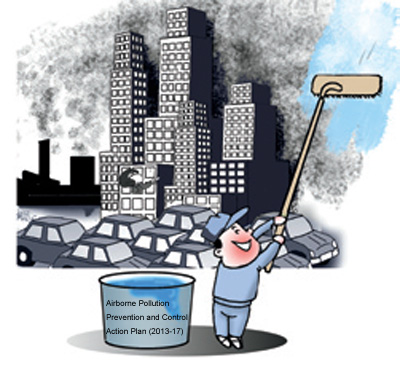|
 |
|
(CFP) |
Once implemented, the phase 5 standards will limit sulfur content to lower than 10 mg per gram of gasoline, reducing nitrogen oxide emissions by an estimated 300,000 tons and fine particle emissions by 30,000 tons annually, according to the MEP.
Focus on Beijing
Under the national action plan, special attention is being given to Beijing and its neighbor Tianjin and Hebei Province.
"The region is being targeted because air pollution is most serious there," Wang Jinnan commented.
According to a MEP statement issued in August, 26.2 percent of days in the first half of the year saw heavy air pollution. This makes the region the worst of the three metropolis clusters monitored by the ministry, the others being the Yangtze River Delta—consisting of Shanghai, Jiangsu Province and Zhejiang Province—and the Pearl River Delta—consisting of the area in south China's Guangdong Province surrounding Guangzhou and Shenzhen.
The average levels of PM 2.5 in Beijing and its surrounding areas' air reached 115 mg per cubic meter, more than three times what the national standard defines as good air quality.
Echoing the national action plan, the Beijing Municipal Government unveiled its own five-year plan on September 12 to improve air quality through measures such as cutting coal consumption, promoting clean energy use and reducing the production of heavily polluting industries. Under the plan, air quality will improve significantly by 2017, with PM2.5 levels to be reduced to around 60 mg per cubic meter.
The plan aims to shut down all of the capital's coal-fired power plants by 2017, with the government cutting annual coal consumption by 13 million tons over the next five years, a reduction to less than half of 2012 levels. Coal burning power plants will be phased out by 2016, with four gas-fired power plants under construction expected to help reduce coal use by 9.2 million tons.
Statistics show that coal accounts for 16.7 percent of Beijing's PM2.5 pollution, second only to the 22.2 percent contributed by vehicle emissions.
The capital currently has 5.35 million vehicles, which consume over 4 million tons of gasoline and more than 2 million tons of diesel annually, said Li Kunsheng, an official in charge of vehicle emissions management at the Beijing Municipal Environmental Protection Bureau.
Annual vehicle emissions are about 900,000 tons and contain 77,000 tons of hydrocarbons and over 80,000 tons of nitrogen oxides, according to Li.
"Vehicle emissions have been proven to contain over 100 carcinogenic substances. Even worse, the emissions are discharged at low altitudes, affecting people's health directly," Li said.
According to the city's plan, by 2017, the number of vehicles in the city is expected to be no more than 6 million, according to the plan.
The city's traffic management and environmental protection bureaus will prepare rules for passenger cars by the end of 2013. The rules are expected to be implemented in 2014 and will mainly focus on time and zone restrictions for personal vehicle use.
By promoting clean energy and low-emission vehicles, reducing the intensity of vehicle use and strictly enforcing regulations, the government expects to reduce total vehicle fuel consumption by 5 percent or more compared to 2012.
In order to clean up the city's air, the Beijing Municipal Government also rolled out measures to curb industrial pollution.
According to the city's plan, 1,200 polluting companies will be ordered to upgrade or close their offending facilities by 2016. Authorities will identify polluters in township- and village-level industrial areas and shut them down if they fail to meet pollution reduction targets.
Starting this year, measurements of sulfur dioxide, nitrogen oxides, dust and volatile organic compound emissions will be a prerequisite for the environmental impact assessments for all new construction projects. As a result, in regions or industries that fail to meet air-pollution reduction targets, no new projects that emit major air pollutants will be given approval.
| 